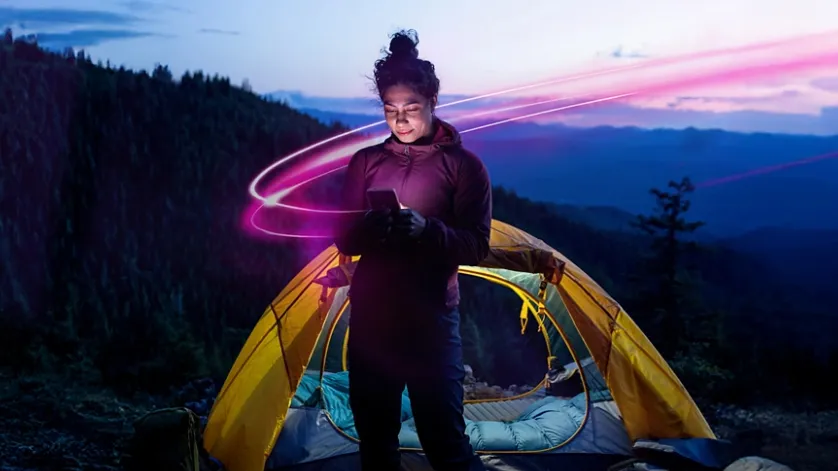In a world where constant connectivity is no longer a luxury but a necessity, T-Mobile’s Starlink satellite service has officially launched, aiming to close the coverage gaps that have plagued remote and rural areas for years. Branded as T-Satellite, the partnership between T-Mobile and Elon Musk’s SpaceX (Starlink) promises to bring text and emergency services even where traditional cell towers don’t reach.
But with Apple offering its own satellite based emergency SOS for free on newer iPhones, how does T-Mobile’s offering compare? The short answer? It depends on your priorities broader device support and carrier level integration, or limited emergency use.
What Phones Support T-Mobile Starlink Satellite Service?
T-Mobile’s satellite texting service is built into its network, allowing compatible smartphones to connect seamlessly. Unlike Apple’s exclusive emergency satellite messaging on iPhones, T-Mobile is taking a broader, more inclusive approach. The service is initially launching with support for a range of Android and iOS devices, including but not limited to. Samsung Galaxy S24, S23, and select S22 models, Google Pixel 8 and Pixel 7 Series, iPhone 14 and newer (on T-Mobile’s network), OnePlus 12 and 11 models.
T-Mobile has committed to expanding compatibility as more devices are optimized to communicate with Starlink’s low earth orbit (LEO) satellites. Dr. Evelyn Hart, a satellite communications specialist at MIT, says, What’s remarkable about T-Mobile’s approach is that it’s carrier integrated, not device gated. That means more users, especially those on older or Android devices, can benefit a significant step toward bridging the digital divide.
How Does T-Satellite Compare to Apple’s Free Emergency SOS?
Apple’s Emergency SOS via satellite has gained praise for saving lives in off grid situations. However, it is limited to emergency use only, doesn’t support two way casual texting, and works exclusively on iPhone 14 and newer models. Apple’s service is currently free for the first two years, after which a subscription model may apply.
In contrast, T-Mobile Starlink satellite service allows for two way text messaging in dead zones, targeting real world usability beyond just emergencies. Whether you’re hiking in the Rockies or driving across Nevada’s deserts, staying connected with friends and family is now a reality.
Real World Testing in Wyoming’s Backcountry
John Matthews, an outdoor photographer based in Wyoming, participated in the beta program and tested T-Satellite during backcountry excursions. I used to carry a separate satellite communicator like a Garmin InReach says Matthews.
Now, I can send updates to clients and family right from my phone, even when I haven’t seen a cell tower in days. It’s freedom and peace of mind rolled into one. This shift reflects a key value proposition: seamless connectivity without carrying extra gear or depending on third-party satellite messaging apps.
Disaster Response and Communication Gaps
In 2023, wildfires in Montana highlighted the fragility of mobile networks during emergencies. Thousands were stranded without communication. T-Mobile’s satellite texting, now officially launched, fills that critical gap. Emergency responders can remain connected when conventional towers fail a critical evolution for both personal safety and public infrastructure.
While Apple’s SOS remains free (for now), T-Mobile Starlink satellite service is expected to be included in most plans at no extra cost, starting with text only functionality. Voice and data are expected in 2025, according to T-Mobile President Mike Sievert.
We’re not just building coverage for today we’re building for the future said Sievert during the launch event. T-Satellite represents freedom from the limits of towers. This aligns with T-Mobile’s broader Un carrier strategy to eliminate traditional boundaries and redefine mobile service accessibility.
Why T-Mobile Starlink Satellite Service Matters
This launch isn’t just a feature addition it’s a revolutionary infrastructure upgrade. By leveraging Starlink’s LEO constellation, T-Mobile transforms each phone into a node capable of bypassing earthbound limitations.
Technological Edge: Unlike Apple’s service, T-Mobile’s T-Satellite is network level, not device specific.
Democratized Access: Android users who make up a majority worldwide are no longer excluded from satellite connectivity.
Public Safety Enhancement: Routine check ins, not just SOS pings, mean better situational awareness for individuals and authorities alike. T-Mobile is essentially making the entire U.S. a cellular coverage zone, says Jason Lu, senior analyst at GSMA Intelligence. That includes areas where even emergency helicopters can’t fly in during bad weather connectivity can now be the difference between rescue and tragedy.
The Road Ahead for Satellite Connected Phones
The T-Mobile Starlink satellite service is more than a tech gimmick it’s a lifeline for millions who live, travel, or work in connectivity deserts. Compared to Apple’s emergency only offering, T-Mobile brings a more robust, inclusive, and scalable solution to the table.
While Apple deserves credit for pioneering mainstream satellite connectivity, T-Mobile’s carrier wide integration through Starlink democratizes it. With more devices, more functionality, and no need to upgrade your phone just to stay safe, T-Satellite is poised to change the mobile landscape forever.

